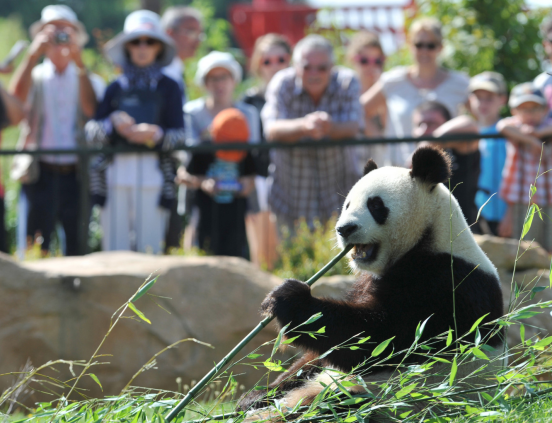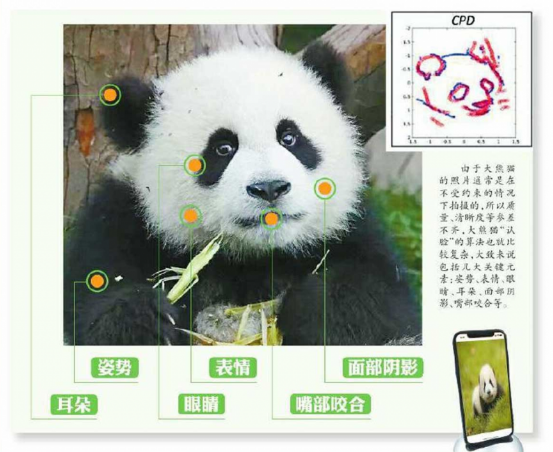「包学习」歪果时事圆滚滚萌萌哒分不清新面部APP帮你识别大熊猫
在可爱的大熊猫面前咱确实都有脸盲症 ,再来看看在满篇英文的情况下是不是也有脸盲症
作者 韩冰
进击的英语君,我们一起加油~
时事背景

当一群萌萌的大熊猫爬到一起,你还分得清楚谁是谁么?大熊猫拥有黑白相间的皮毛及别具一格的“黑眼圈”,个体之间看起来十分相似,难以区别。不过爱熊猫人士不用再担心啦,大熊猫“认脸”APP即将推出,专治熊猫脸盲!
外刊时文简读 (PS:下拉可读译文)
字数:295 建议阅读时间:6' 考纲话题:生活娱乐 难度:中 新闻来源:Washington Post
Having trouble discerning (弄清楚) one furry panda from another? A facial recognition (面部识别) app will make it easy for you.

The app is developed by the Chengdu Research Base of Giant Panda Breeding (成都大熊猫繁育研究基地) along with researchers in Singapore Nanyang Technological University (新加坡南洋理工大学) and Sichuan Normal University (四川师范大学).

Visitors to the panda base in the Sichuan capital of Chengdu, one of China's top tourist attractions, will be able to scan (扫描) the panda's face with the mobile app to get information about that particular bear.

The image analysis research kicked off in 2017. A database now contains about 120,000 images and 10,000 video clips of giant pandas. Close to 10,000 panda pictures have been analyzed, marked and annotated (注释). Using the database, researchers are able to carry out automatic facial recognition on panda faces to tell one animal from another, the center said.

"The app and database will help us gather more precise and well-rounded data on the population, distribution, ages, gender ratio (性别比例), birth and deaths of wild pandas, who live in deep mountains and are hard to track," said Chen Peng, a researcher with the base who co-authored a paper on "Giant Panda Face Recognition Using Small Database".

"It will definitely help us improve efficiency (效率) and effectiveness (有效性) in conservation and management of the animals," Chen said.

China has carried out four scientific field research project of giant pandas in the wild.
The number of captive (被圈养的) pandas was 548 globally as of November last year. Fewer than 2,000 pandas live in the wild, mostly in the provinces of Sichuan and Shaanxi.
【Word Bank】
① particular /pə'tɪkjʊlə/ adj. 特定的
② distribution /ˌdɪstrɪˈbjuːʃn/ n. 分布
③ conservation /ˌkɒnsəˈveɪʃn/ n. 保护
【Cultural Note】
① 成都大熊猫繁育研究基地(Chengdu Research Base of Giant Panda Breeding),位于中国四川省成都市成华区外北熊猫大道1375号,距市中心10千米,距成都双流国际机场30千米,是世界著名的大熊猫迁地保护基地、科研繁育基地、公众教育基地和教育旅游基地。基地占地面积1500亩。作为"大熊猫迁地保护生态示范工程",以保护和繁育大熊猫、小熊猫等中国特有濒危野生动物而闻名于世。
【T or F Quiz】(下拉对答案)
① Researchers from Beijing Normal University joined the development of the facial recognition app.
T( ) F( )
② More than 2,000 pandas live in the provinces of Sichuan and Shaanxi.
T( ) F( )
【Touch Your Heart】
我才不是没睡好,我只是画了烟熏妆!
【Key to Quiz】
① F ② F
【译文】
分不清楚毛茸茸的大熊猫?一款面部识别应用程序能让你轻松分辨。
这款应用由成都大熊猫繁育研究基地、新加坡南洋理工大学和四川师范大学的研究人员共同开发。
作为中国最著名的旅游景点之一,前往该基地参观的游客只要使用该应用程序扫描熊猫面部,就能获知每只熊猫的信息。
这项图片分析研究在2017年开始,数据库中现有大约12万张大熊猫图片和1万段大熊猫视频。研究人员分析、标记和注释了将近1万张大熊猫图片。研究中心称,通过使用数据库,研究人员可以对大熊猫的脸部进行自动面部识别,以区分不同的大熊猫。
论文《基于小数据集的大熊猫个体识别》作者之一、成都大熊猫繁育研究基地研究员陈鹏说:“这款应用和数据库将帮助我们收集有关野生大熊猫数量、分布、年龄、性别比例、出生和死亡的更准确全面的数据,它们生活在深山中,很难追踪。”
他说:“这款应用必然能帮助我们提高保护和管理大熊猫的效率和有效性。”
中国已经开展了四项针对野生大熊猫的科学实地考察项目。
截至去年11月,全球共有548只圈养大熊猫。生活在野外的大熊猫不到2000只,大部分在四川省和陕西省。
分辨大熊猫的能力固然重要,但是有一个好的英语水平更加重要,不然怎么学习文中的辨别知识呢,包学习APP就能轻松搞定

本文转载自歪果时事





















评论